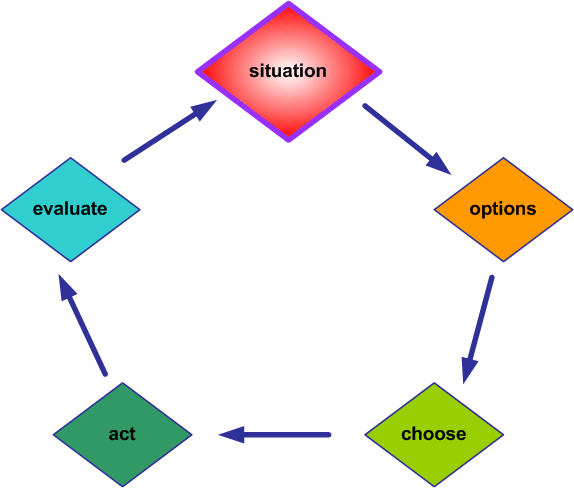The Pilot Decision-making Process
When faced with a non-normal or critical event, effective management by the pilot will require an effective decision-making process that maximizes the potential for successful resolution. Here are the phases of effective decision-making process:

Situation
A situation is the set of circumstances that the pilot is faced with. More specifically, the situation—in so far as we are concerned with here—is critical, and therefore the decisions made are critical. The most important aspect of this part of the decision-making process, however, is that the pilot must be first aware of the impending critical situation. Once you are aware of the situation, you can begin to find a remedy—if you are not aware of an unfolding situation, you cannot even get to first base.
The classic example of this is controlled flight into terrain—CFIT. In all of the CFIT accident cases, the pilots were clearly not aware of the critical circumstances with which they were faced. Quite a few years back, a Canadian Armed Forces C-130 flew into terrain in a controlled fashion while on approach into Alert. The incident occurred at night and the pilot, still many miles back from the airport, had visual reference of the distant airport. Surrounding the airport was utter blackness. As the aircraft gradually descended dangerously close to the ice ridges, one of which the aircraft eventually made contact with, there must have been a period of time—albeit short—when the ridges where zipping past just below the aircraft fuselage. The pilot, however, was not aware of the situation.
Perhaps the most classic case of CFIT is the Eastern 401 accident, which is presented below as a case study. Here the transcript from the minutes leading up to ground impact are truly indicative of the factors that can conspire to make pilots unaware of the deadly situation in which they eventually—perhaps just before impact—find themselves. Nevertheless, we must remember that the pilot decision-making process requires that the pilot is first aware of the situation—he or she must have situational awareness. If we are not aware, we cannot begin to resolve matters towards a favourable outcome. If there is situational awareness, the rest of the problem is quite straightforward and natural.
Options
Once a problem occurs, and you are aware of it, the most important thing is to give yourself as many options as possible. Two things to note here, the first is that options are—when faced with a critical situation—like gold. The more options you have, the better your chances of a successful outcome. Remember, options are often merely ideas which, when first considered as an option, may or may not be viable. Further brain-time must be spent on them so that the outcome can be predicted. Some options are better than others, so the more options you can think of, the greater the likelihood of success. Sometimes, though, there is only one option and choice is therefore not involved—a classic example of this is an emergency forced approach resulting from a catastrophic engine failure. There is only one option and you must follow it through successfully. But single-option situations are incredibly rare birds. Since they are so rare, you should be skeptical if you feel your options are limited—perhaps more options exist that you have not considered.
A second interesting feature of options is that they are the product of the “higher” brain—the cerebral cortex. The cerebral cortex is designed to shut down and give way to the lower brain in moments of panic. The cerebral cortex, for example, allows you to predict and reason that the chances of successfully defending yourself against a grizzly bear are in fact quite small—the size, the teeth, the strength, the claws, etc. This is a reasoning process. In contrast, a panic response is a “lower” brain function, which shuts-down the reasoning process—panic is powered by adrenaline, not reason, and therefore undermines the rational assessment of options.
Choose
Assess risk and choose a course of action. If the “option” phase of the decision-making process is based on creative ideas, the “choose” phase is based on creative assessment. Again, this is a higher brain process, involving reason, and prediction. If panic forms the basis of any choice, the rational assessment process is undermined.
Act
Time is important. A pilot encountering airframe-icing conditions without counter-icing equipment has only seconds to react. Even in less critical circumstances, however, time is in fact a scarce resource for all pilots—time is related to fuel consumption. On every flight there is only so much time you can spend in the air. Be sure to take action before time—and fuel—runs out.
Time limits can take other forms. After an alternator or generator failure, there is only so much electrical energy in the battery. While battery energy may not be consequential to a day VFR flight, it would become critical for a night VFR or IFR flight. Daylight is certainly a scarce resource for the float-plane pilot.
Time can also be controlled by the pilot. Consider the decision to proceed on a cross-country flight into mountainous terrain. The pilot who presses on to have “look-see” is suddenly placed in a time-limited environment, while the pilot who takes the time to sort out weather data prior to launch has all the time in the world.
Evaluate
Has the selected action been successful? Once an act is committed, a new situation presents itself requiring new decision-making.
.jpg)

